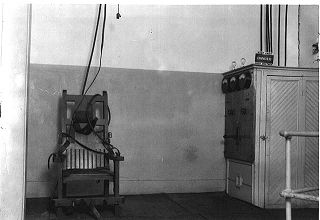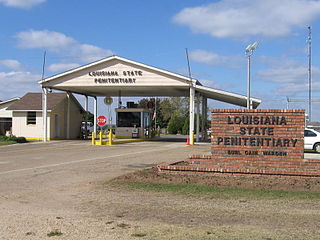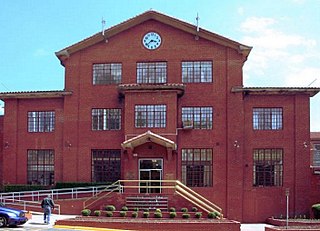
In This Timeless Time: Living and Dying on Death Row in America is a 2012 book by Bruce Jackson and Diana Christian, published by the University of North Carolina Press. [1]

In This Timeless Time: Living and Dying on Death Row in America is a 2012 book by Bruce Jackson and Diana Christian, published by the University of North Carolina Press. [1]
The authors are married to one another and Helicher had previously studied prisons for around 40 years. [2] They did not have formal work experience in criminology and history-related jobs. [3]
The title "timeless time" refers to a saying of how staying on death row feels like, as the prisoners are not aware of their ultimate fate. [2]
The authors previously created the documentary film Death Row. [1]
The initial section is a memorial to executed prisoners, reflecting the authors' philosophy opposing the death penalty. [3]
The book has three sections. The first includes photographs of condemned inmates, [4] in the Ellis Unit in Walker County, Texas in 1979. [5] Those inmates had been put to death. [2] Alan G. Pike of Emory University wrote that the death row living situation is "monotonous and oppressive". [5] The book has a total of 113 black-and-white photographs, [4] all in duotone, [1] and twelve inmates were depicted. [2] The photographs make up most of the work. [1]
The second, "Words", discusses the legal processes, [2] the outcomes, [5] and daily lives of death row inmates. [2] This section serves as the captions to the images of the first. [5]
The third, "Working", discusses the processes the authors used to get their research material, [5] and ethics-based arguments regarding the death penalty. [2]
The book includes a DVD containing a 1979 documentary, [2] Death Row , including interviews of Ellis Unit capital punishment prisoners, made by the authors. Pike called it "exceptional". [5]
Frances Sandiford, a former librarian of the Green Haven Correctional Facility, wrote that the book was in a "direct, journalistic style, poignant and to the point." [6] She indicated a highly positive review with a star symbol. [4]
Pike wrote that the book is "a uniquely powerful contribution" to the subject and that it has "compelling" components. [5]
Karl Helicher of ForeWord wrote that the book "would benefit" persons interested in the American death penalty and the associated penal system. [2]
Alex Tepperman, a PhD student in history at the University of Florida, concluded that the book "is a moving piece of photojournalism and a fitting argument against the death penalty". [3] Tepperman believed the first part was the best but felt the second and third were not as good. [3]
Publishers Weekly wrote that the book was "comprehensive" and "well-crafted". [1] PW stated that overall the book "raises important questions" about the death penalty and the legal system; the review criticized how there are multiple photographs of different angles of the same events and general repetition at times. [1]

San Quentin Rehabilitation Center (SQ), formerly known as San Quentin State Prison, is a California Department of Corrections and Rehabilitation state prison for men, located north of San Francisco in the unincorporated place of San Quentin in Marin County.

Old Sparky is the nickname of the electric chairs in Arkansas, Connecticut, Florida, Georgia, Illinois, Kentucky, Nebraska, New York, Ohio, Oklahoma, South Carolina, Texas, Virginia, and West Virginia. Old Smokey was the nickname of the electric chairs used in New Jersey, Pennsylvania, and Tennessee. "Old Sparky" is sometimes used to refer to electric chairs in general, and not one of a specific state.

The Louisiana State Penitentiary is a maximum-security prison farm in Louisiana operated by the Louisiana Department of Public Safety & Corrections. It is named "Angola" after the former slave plantation that occupied this territory. The plantation was named after the country of Angola from which many slaves originated before arriving in Louisiana.

Mississippi State Penitentiary (MSP), also known as Parchman Farm, is a maximum-security prison farm located in the unincorporated community of Parchman in Sunflower County, Mississippi, in the Mississippi Delta region. Occupying about 28 square miles (73 km2) of land, Parchman is the only maximum security prison for men in the state of Mississippi, and is the state's oldest prison.
Bang Kwang Central Prison is a men's prison in Nonthaburi Province, Thailand, on the Chao Phraya River about 11 km north of Bangkok. It is a part of the Department of Corrections.

Capital punishment is a legal penalty in the U.S. state of Texas for murder, and participation in a felony resulting in death if committed by an individual who has attained or is over the age of 18.

Texas State Penitentiary at Huntsville or Huntsville Unit (HV), nicknamed "Walls Unit", is a Texas state prison located in Huntsville, Texas, United States. The approximately 54.36-acre (22.00 ha) facility, near downtown Huntsville, is operated by the Correctional Institutions Division of the Texas Department of Criminal Justice. The facility, the oldest Texas state prison, opened in 1849.

Oregon State Penitentiary (OSP), also known as Oregon State Prison, is a maximum security prison in the northwest United States in Salem, Oregon. Originally opened in Portland 173 years ago in 1851, it relocated to Salem fifteen years later. The 2,242-capacity prison is the oldest in the state; the all-male facility is operated by the Oregon Department of Corrections (ODOC). OSP contains an intensive management wing, which is being transformed into a psychiatric facility for mentally ill prisoners throughout Oregon.

The Texas Department of Criminal Justice (TDCJ) is a department of the government of the U.S. state of Texas. The TDCJ is responsible for statewide criminal justice for adult offenders, including managing offenders in state prisons, state jails, and private correctional facilities, funding and certain oversight of community supervision, and supervision of offenders released from prison on parole or mandatory supervision. The TDCJ operates the largest prison system in the United States.
Christa Gail Pike is an American convicted murderer, and the youngest woman to be sentenced to death in the United States during the post-Furman period. She was 20 when convicted of the torture murder of her classmate Colleen Slemmer, which she committed at age 18.

The 1974 Huntsville Prison siege was an eleven-day prison uprising that took place from July 24 to August 3, 1974, at the Huntsville Walls Unit of the Texas Department of Corrections in Huntsville, Texas. The standoff was one of the longest hostage-taking sieges in United States history.

Allan B. Polunsky Unit is a prison in West Livingston, unincorporated Polk County, Texas, United States, located approximately 5 miles (8.0 km) southwest of Livingston along Farm to Market Road 350. The Texas Department of Criminal Justice (TDCJ) operates the facility. The unit houses the State of Texas death row for men, and it has a maximum capacity of 2,900. Livingston Municipal Airport is located on the other side of FM 350. The unit, along the Big Thicket, is 60 miles (97 km) east of Huntsville.
Death row, also known as condemned row, is a place in a prison that houses inmates awaiting execution after being convicted of a capital crime and sentenced to death. The term is also used figuratively to describe the state of awaiting execution, even in places where no special facility or separate unit for condemned inmates exists. In the United States, after an individual is found guilty of a capital offense in states where execution is a legal penalty, the judge will give the jury the option of imposing a death sentence or life imprisonment without the possibility of parole. It is then up to the jury to decide whether to give the death sentence; this usually has to be a unanimous decision. If the jury agrees on death, the defendant will remain on death row during appeal and habeas corpus procedures, which may continue for several decades.

O. B. Ellis Unit is a Texas Department of Criminal Justice prison located in unincorporated Walker County, Texas, 12 miles (19 km) north of Huntsville. The unit, with about 11,427 acres (4,624 ha) of space, now houses up to 2,400 male prisoners. Ellis is situated in a wooded area shared with the Estelle Unit, which is located 3 miles (4.8 km) away from Ellis. From 1965 to 1999 it was the location of the State of Texas men's death row.

The John M. Wynne Unit (WY) is a men's prison of the Texas Department of Criminal Justice, located in northern Huntsville, Texas, at the intersection of Farm to Market Road 2821 West and Texas State Highway 75 North. The Windham School District has its headquarters in the unit. Wynne, the second oldest prison in Texas, was named after John Magruder Wynne, who served as a prison employee and later as a board member of the prison system from 1878 to 1881. The unit, on a 1,412 acres (571 ha) plot of land, is co-located with the Holliday Unit.

The Thomas Goree Unit (GR) is a Texas Department of Criminal Justice men's prison, located in Huntsville, Texas, 4 miles (6.4 km) south of downtown Huntsville on Texas State Highway 75 South. The Goree Unit is located within Region I. First opened in 1911, it served as the only women's correctional facility in Texas until 1982, after the women were moved to state prisons in Gatesville. For a period Goree held the state's sole female death row inmate, until her conviction was changed to a non-capital offense. There was more than one death row female at Goree in 1979.

The Captain Joe Byrd Cemetery is the main prison cemetery in Texas, located in Huntsville and operated by the Texas Department of Criminal Justice (TDCJ). The colloquial name for the cemetery is Peckerwood Hill. The name originates from "Peckerwood", an insult towards poor white people, because many of those buried at the cemetery were poor.
Texas Tough: The Rise of America's Prison Empire is a 2010 book by Robert Perkinson, published by Metropolitan Books.
Behind the Walls: A Guide for Families and Friends of Texas Prison Inmates is a 2002 book by Jorge Renaud, published by University of North Texas Press. It is aimed at relatives and friends of inmates at the Texas Department of Criminal Justice (TDCJ).